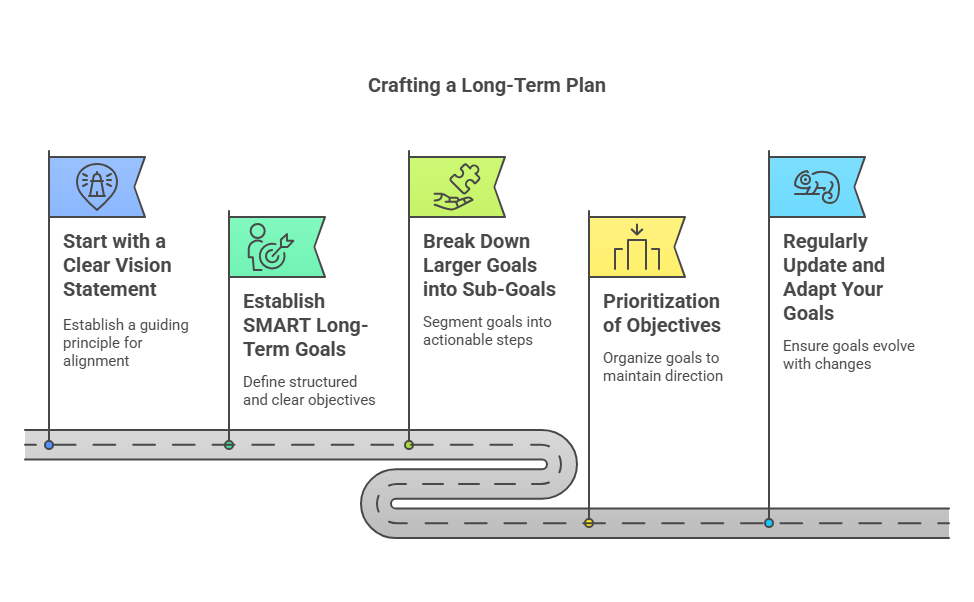Exploring the Advantages of Long-Term Planning for Businesses and Individuals
Long-term planning is essential in guiding both organizations and individuals toward their aspirations. It entails defining specific objectives and devising a detailed strategy to accomplish them over an extended timeline. This article delves into the merits of looking ahead, including heightened financial resilience, sharpened strategic choices, and a solidified sense of direction. Grasping these advantages enables a clearer vision for future prosperity.
Understanding Long-Term vs Short-Term Planning
Definition of Short-Term Planning
Short-term planning tackles immediate objectives within a finite period. It empowers organizations to surmount present challenges, capitalize on pressing opportunities, and pivot amid fluctuating market trends. A retail outlet, for instance, might execute a short-term maneuver to boost holiday sales through specialized promotions and adjusted stock to match expected surges in consumer demand.
Conversely, a tech enterprise may hasten the roll-out of a product enhancement within a quarter to incorporate user feedback, thereby enhancing customer satisfaction.
Responsiveness to nuanced marketplace shifts and acute customer needs is vital. These strategies enable businesses to navigate their day-to-day landscape with agility, ensuring operational continuity and adaptability.
Definition of Long-Term Planning
Long-term planning establishes a vision and delineates a trajectory to achieve it, fostering sustained development and performance. It promotes strategic foresight, coordinated goal alignment, and judicious resource deployment while employing metrics like Key Performance Indicators (KPIs) for progress assessment. This vigilant planning offers an enterprise a proactive stance in sculpting its destiny.
The Core Differences between Long-Term and Short-Term Objectives

The distinction between long-term and short-term objectives underpins an enterprise’s enduring expansion. Immediate objectives gear towards punctual results, like hitting quarterly sales quotas. In contrast, long-range objectives set the trajectory towards overarching ambitions, such as achieving market expansion in five years.
A manufacturing firm might focus on curtailing production expenses as a short-term aim while transitioning to renewable energy sources marks a decade-spanning endeavor. This bifurcation allows for strategic resource allocation and precise progress tracking, thereby assisting in nurturing stable progression.
Top Benefits of Long-Term Planning for Businesses

Sustaining a Competitive Advantage
Long-term planning is indispensable for a business in cultivating a culture of anticipation and endurance. It bolsters a unified approach, linking day-to-day choices with determined organizational pursuits. By having off-site retreats, a company can focus on comprehensive strategy development without routine distractions. Anticipating the unanticipated cultivates a robust enterprise ready to confront forthcoming challenges.
A business with a prospective mindset displays resilience and thrives in a demanding marketplace. Crafting a long-term strategy anchors an organization’s journey toward resilience and industry leadership.
Facilitating Progressive Growth
Long-term planning sets the stage for enduring organizational progress and operational success. It fosters a progressive culture where continuous improvement and risk management are integral to business operations. Establishing lucid strategic goals equips an enterprise to diffuse uncertainties and seize future opportunities.
This preparedness extends to all facets of an organization, enhancing operational command, iterating innovations, and shaping businesses to adapt and thrive amid competitive and fluctuating economic environments.
Enhancing Operational Efficiency
Looking beyond the immediate horizon enables businesses to optimize their operational efficiency. A coherent long-term strategy facilitates a harmonious direction for all team members, promoting informed decision-making. Anticipating future adversities and having a contingency plan ensures the company remains steadfast amid challenges.
Long-term planning incorporates a defensive stance to risk and encourages a workforce’s commitment, resulting in a dynamic environment that nurtures a company’s persistence in a competitive field.
Crucial Reasons for Individual Long-Term Planning

Achieving Personal Goals and Aspirations
A long-term strategy acts as a compass for individuals, guiding them toward their milestones. It fosters a synergy between immediate tactics and long-range ambitions, leading to calculated decisions and strategic risk-taking. Aligning short-term goals with a broader vision elevates personal and organizational efficacy, offering clarity and trajectory for the future.
This forward-looking mentality underpins success and navigates one through career and financial planning complexities.
Fostering Financial Stability
Financial foresight is a cornerstone of long-term planning. Establishing a resilient financial base enables a business to endure market turbulence. Organizations that proactively manage finance position themselves to invest in development, market expansion, and innovation, leading to novel profit channels.
Additionally, it aids in formulating risk management processes and setting the stage for swift recovery from disruptions, all of which contribute to a stable and enduring financial trajectory.
Strategic Planning vs. Long-Term Planning: Unveiling the Distinction
Strategic planning is vital to an organization’s vision for sustainable development. Similar in nature to long-term planning, it encompasses setting and adjusting goals while measuring progress against KPIs. Such planning elucidates a clear direction and nurtures a motivated, committed workforce that gravitates toward the company’s aspirations.
Strategic planning creates a roadmap that delineates the way forward, effectively engaging all stakeholders in the company’s trajectory.
Crafting a Long-Term Plan: A Step-by-Step Approach

Start with a Clear Vision Statement
Initiating long-term planning with an articulate vision statement lays the foundation for business alignment and strategic decision-making. This guiding principle aids in framing short-term objectives to bolster the overarching mission, ensuring unity in direction and a stronger organizational fabric. Visionary planning preempts potential hindrances, providing a lighthouse for navigation through uncertain times and fostering adaptability, sturdiness in structure, and continuity in growth.
Establish SMART Long-Term Goals
Defining SMART goals anchors a business’s journey toward its future state. These goals lend structure and clarity, transforming a long-term vision into tangible milestones. They bolster firm-focused decision-making and fuel dedicated resource management. Establishing such targeted objectives engenders staff dedication and propels the organization toward its ultimate ambitions.
Break Down Larger Goals into Sub-Goals
Segmenting broader aims into actionable sub-goals keeps the momentum toward overarching strategic pursuits. This process ensures consistency in efforts, with employees rallying around a unified purpose. It streamlines resource allocation and emphasizes the importance of constant evaluation, facilitating an inspiring and results-driven culture.
Prioritization of Objectives
Prioritizing goals is integral for maintaining strategic direction and optimizing resource investment. It informs decision-making processes and ensures enterprise activities point towards the long-term vision. An organized hierarchy of objectives enhances organizational cohesion and individual investment in the company’s success.
Regularly Update and Adapt Your Goals
Adaptable goal setting is indispensable for an established long-term plan. It ensures that strategy evolves in step with market advances and organizational changes, retaining relevance and practicality. This evolutionary approach to goal management maintains competitiveness and upholds an organization’s commitment to its long-range aims.

Vizologi is a revolutionary AI-generated business strategy tool that offers its users access to advanced features to create and refine start-up ideas quickly.
It generates limitless business ideas, gains insights on markets and competitors, and automates business plan creation.


